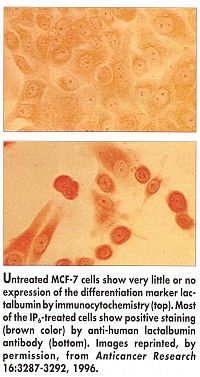IP6 (Phytic Acid) Inhibits Breast Cancer in Animals
WASHINGTON-Inositol hexa-phosphate (IP6) has shown antitumor effects in vitro and in animal models and may be ready for clinical trials in humans, said Ivana Vucenik, PhD, associate professor of medical and research technology, University of Maryland School of Medicine, Baltimore. She presented her study results at the Susan G. Komen Breast Cancer Foundation grants conference "Reaching for the Cure."
WASHINGTONInositol hexa-phosphate (IP6) has shown antitumor effects in vitro and in animal models and may be ready for clinical trials in humans, said Ivana Vucenik, PhD, associate professor of medical and research technology, University of Maryland School of Medicine, Baltimore. She presented her study results at the Susan G. Komen Breast Cancer Foundation grants conference "Reaching for the Cure."
IP6 (or phytic acid) is found in grains, cereals, and legumes. It appears to be the component that gives fiber its antican-cer effect. Previous research has shown that only dietary fiber containing IP6 has a negative correlation with colon cancer, Dr. Vucenik said.
The substance plays a vital role in cell function, she said, and works by entering the intracellular space. Once seen as a passive element in the cell, IP6 has now been shown to be a very strong antioxidant, a neurotransmitter, and a crucial factor in exporting messenger RNA.

A combination of IP6 and inositol proved better than either compound separately at inhibiting tumor growth, possibly because together they yield inositol triphosphate (IP3), which regulates cell growth, she said.
In vivo animal studies showed reduced tumor sites, incidence, and number, protecting the animals against both induced and spontaneously appearing tumors. In vitro studies using both MCF-7 estrogen-receptor (ER) positive and MDA-MB 231 ER-negative human breast cancer cells showed that IP6 inhibited cell growth and increased differentiation.
While the mechanism of action is not entirely clear, Dr. Vucenik said, it may be due, in part, to activation of protein kinase C-delta (PKC-delta). IP6 induces overexpression of PKC-delta, and activated PKC-delta upregulates p27, which in turn induces cancer cells to stop growing. She noted that breast cancer patients with higher p27 levels have better clinical outcomes than those with lower p27.
Dr. Vucenik said that while the mechanism of action of IP6 deserves more study, it is safe and has no adverse effects at normal doses. In humans, Dr. Vucenik has only heard anecdotal reports of anticancer effects of IP6, which is available over the counter as a dietary supplement.
Dr. Vucenik and others have shown some cardiologic benefits of IP6, including lowering triglycerides and antiplatelet activity. With her colleague Abulkalam M. Shamsuddin, MD, PhD, professor of pathology, University of Maryland, she is now preparing early clinical trials in healthy volunteers to test these effects.